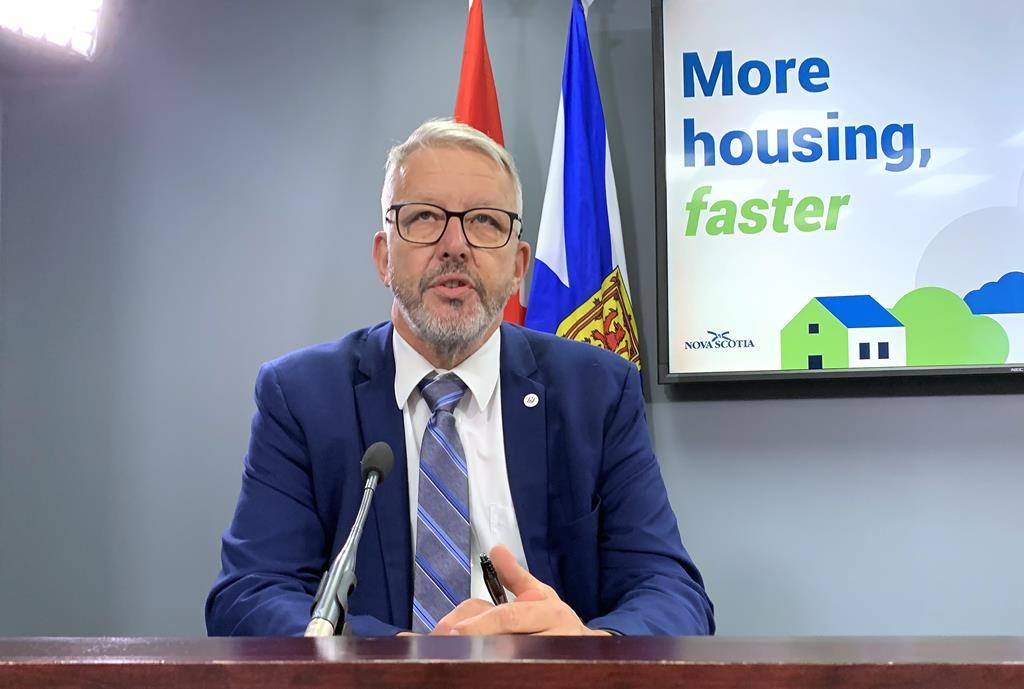Nova Scotia government lays out plan to reduce 41K home shortage by 2028

Posted Oct 23, 2023 01:13:02 PM.
Last Updated Oct 23, 2023 05:49:17 PM.
Nova Scotia’s Progressive Conservative government released a housing plan Monday that it says will help address a projected shortage of 41,000 homes by 2028.
A study completed by consultant Turner Drake & Partners says rapid inflation, high interest rates, shortages of labour and one of the fastest population-growth rates in the country has already created a shortage of 27,300 units in the province — along with spiraling housing costs.
“Nova Scotia’s housing market is currently unsustainable and will only be exacerbated if immediate action … is not taken,” the report says.
The study, based partly on survey responses from 20,000 people, says 54 per cent of respondents said they had to spend more than 30 per cent of their income on housing, and 46 per cent said they couldn’t find a place to rent in their price range.
Housing Minister John Lohr told a news conference the province is planning to spend $1 billion over the next five years “to create the conditions” to increase the housing supply.
“This is the first time ever in Nova Scotia that we’ve had this level of data to inform our way forward,” he said.
He said the province will continue with 12 actions, which include helping community groups build 17,250 “affordable units,” increasing spending to repair existing units, and reducing regulations for builders.
Many initiatives in the plan are a continuation of previously announced programs, including providing provincial public lands to develop mix-incomed housing with community groups, and constructing modular housing for health-care workers and those in the skilled trades.
Last week, the government introduced a “backyard suite” incentive program to encourage homeowners to add rooms to house family members and provide rental units.
The province says it’s also continuing a program to help non-profit groups purchase and maintain affordable housing through repayable, low-interest loans of up to $10 million per project.
Lohr said the province will be “nimble” in tying in with federal housing initiatives, as it attempts to increase the current level of about 6,000 new housing units being built per year.
“It is a plan for hope,” Lohr said.
However, opposition critics pointed to a lack of clear commitments to build publicly owned and operated housing, which some municipal leaders see as the solution for lower-income residents.
On Sept. 27, Lohr announced Nova Scotia was joining with Ottawa to pay for 222 public housing units, spread across five communities. However, the waiting list for public housing is close to 5,000 people, while tent encampments in Halifax parks remain a visible reminder of the shortages.
Lohr said the government is working on a pilot project to follow the model of Regent Park in Toronto, where public housing is redeveloped to create a mixed-income neighbourhood.
“If that (pilot project) is successful, this will figure in the regeneration of public housing,” the minister said.
Braedon Clark, the Liberal housing critic, said Lohr’s plan “was less of a strategy and more a summary of ideas that have already been put in place, many of which have not shown much result in terms of easing the housing crisis.”
Suzy Hansen, NDP member of the legislature for Halifax Needham, said the Tory plan lacks a definition of what an affordable rent or mortgage is, and she said it doesn’t set clear goals. “It doesn’t give us any indication of how many more public housing units will be built,” she said.
The housing study was called for two years ago in a special report by the Nova Scotia Affordable Housing Commission, which was created following a public outcry in 2020 over a series of widely publicized evictions of low-income tenants and rising homelessness.
This report by The Canadian Press was first published Oct. 23, 2023.








